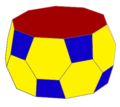This article includes a list of references, related reading, or external links, but its sources remain unclear because it lacks inline citations .(March 2025) |
| Uniform pentagonal antiprism | |
|---|---|
 | |
| Type | Prismatic uniform polyhedron |
| Elements | F = 12, E = 20 V = 10 (χ = 2) |
| Faces by sides | 10{3}+2{5} |
| Schläfli symbol | s{2,10} sr{2,5} |
| Wythoff symbol | | 2 2 5 |
| Coxeter diagram | |
| Symmetry group | D5d, [2+,10], (2*5), order 20 |
| Rotation group | D5, [5,2]+, (522), order 10 |
| References | U 77(c) |
| Dual | Pentagonal trapezohedron |
| Properties | convex |
 Vertex figure 3.3.3.5 | |

In geometry, the pentagonal antiprism is the third in an infinite set of antiprisms formed by an even-numbered sequence of triangle sides closed by two polygon caps. It consists of two pentagons joined to each other by a ring of ten triangles for a total of twelve faces. Hence, it is a non-regular dodecahedron.



